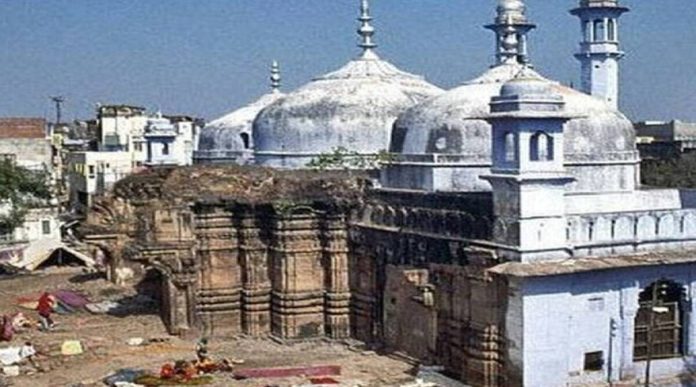On Monday morning, a group from the Archaeological Survey of India started the scientific investigation of the Gyanvapi mosque complex in Varanasi.
People with knowledge of the situation claimed on Sunday that the survey is taking place despite the mosque management committee’s petition to the Supreme Court against the district court’s order permitting the inspection.
The ASI team arrived in Varanasi on Sunday with all the necessary tools.
A UP Police unit can be seen entering the Gyanvapi mosque compound as the ASI assessment started in a video that news agency ANI released.
There are about 40 people involved, including representatives from ASI, the management committee at the Gyanvapi mosque, four plaintiffs who identify as Hindu women, and their attorneys.
No members of the Anjuman Intezamia Masajid Committee are taking part in the survey.
Joint Secretary SM Yasin of the committee declared, “We have disregarded the ASI survey”. We aren’t there (at the Gyanvapi mosque) for the ASI survey, and neither is our advocate. We’re not taking part in it.
In response to a petition by the Hindu side requesting that the ASI be directed to conduct a “scientific survey” of the entire Gyanvapi mosque grounds, the Varanasi court issued its ruling.
Five women who had previously requested permission to pray at the “Shringar Gauri Sthal” inside the shrine complex submitted the petition in May.
On May 16 of last year, a building that was allegedly a “Shivling” by the Hindu side and a “fountain” by the Muslim side was discovered during a court-ordered inspection of the mosque close to the Kashi Vishwanath temple.
“This is a very glorious moment for us for the Hindu community and crores of Hindus, the survey is the only possible solution to this Gyanvapi issue,” Sohan Lal Arya, one of the petitioners in the Gyanvapi mosque case told ANI.
Varanasi court’s ruling on the case.
The Varanasi district court issued an order on Friday for the ASI to conduct a thorough study of the Gyanvapi masjid in order to determine whether the mosque was constructed over an earlier Hindu temple.
The court reasoned that this was “necessary” in order for the “true facts” to emerge.
However, the court ruled that the part be excluded because it has been sealed since the Supreme Court’s judgment in May 2022.
Muslims contend that the area under the seal is actually a portion of a fountain, whereas Hindus assert that a Shivling has been discovered there.
“On Monday, the ASI survey will start. According to Varanasi district magistrate S Rajalingam,” all the parties, including plaintiffs and defendants involved to the matter, have been informed about it.
Following an order from the Allahabad high court, the Varanasi district court had on May 16 consented to hear a request for an ASI survey.
Supreme Court ruling on the Gyanvapi mosque.
The alleged “shivling,” discovered after another court requested a video survey of the facility, had earlier been deemed protected by the Supreme Court.
The administration of the mosque insisted that the building is a component of the fountain system at the “wazukhana,” the reservoir where worshippers bathe before saying namaz.
Lawyers for the mosque at one point asserted that the Place of Worship (Special Provisions) Act, 1991, was breached and that the Kashi Vishwanath-Gyanvapi mosque lawsuit could not be maintained.
This regulation prohibited altering any house of worship’s nature from what it was on August 15, 1947. However, the Ram Janmabhoomi-Babri Masjid legal controversy was exempt from the Act.
Raju Das, the Hanumangarhi mahant of Ayodhya, is pleased with the Varanasi court’s ruling. The chief priest of Ram Janmabhoomi Satyendra Das claimed that the seers are overjoyed about it.
The Varanasi district court issued the order for the ASI survey to bring out the “true facts” of the case while excluding a sealed portion based on the Supreme Court’s previous ruling.
The entire process has been closely watched, with the Muslim side asserting that the sealed area is part of a fountain, while the Hindu side claims it houses a Shivling.
The situation remains complex, with both sides presenting their arguments based on historical and religious significance.
On Monday morning, a group from the Archaeological Survey of India started the scientific investigation of the Gyanvapi mosque complex in Varanasi.
On Monday morning, a team from the Archaeological Survey of India (ASI) started a scientific survey of the Gyanvapi mosque complex in Varanasi, Uttar Pradesh.
People with knowledge of the situation claimed on Sunday that the survey is taking place despite the mosque management committee’s petition to the Supreme Court against the district court’s order permitting the inspection.
The ASI team arrived in Varanasi on Sunday with all the necessary tools.
A UP Police unit can be seen entering the Gyanvapi mosque compound as the ASI assessment started in a video that news agency ANI released.
There are about 40 people involved, including representatives from ASI, the management committee at the Gyanvapi mosque, four plaintiffs who identify as Hindu women, and their attorneys.
No members of the Anjuman Intezamia Masajid Committee are taking part in the survey.
Joint Secretary SM Yasin of the committee declared, “We have disregarded the ASI survey”. We aren’t there (at the Gyanvapi mosque) for the ASI survey, and neither is our advocate. We’re not taking part in it.
In response to a petition by the Hindu side requesting that the ASI be directed to conduct a “scientific survey” of the entire Gyanvapi mosque grounds, the Varanasi court issued its ruling.
Five women who had previously requested permission to pray at the “Shringar Gauri Sthal” inside the shrine complex submitted the petition in May.
On May 16 of last year, a building that was allegedly a “Shivling” by the Hindu side and a “fountain” by the Muslim side was discovered during a court-ordered inspection of the mosque close to the Kashi Vishwanath temple.
“This is a very glorious moment for us for the Hindu community and crores of Hindus, the survey is the only possible solution to this Gyanvapi issue,” Sohan Lal Arya, one of the petitioners in the Gyanvapi mosque case told ANI.
Varanasi court’s ruling on the case.
The Varanasi district court issued an order on Friday for the ASI to conduct a thorough study of the Gyanvapi masjid in order to determine whether the mosque was constructed over an earlier Hindu temple.
The court reasoned that this was “necessary” in order for the “true facts” to emerge.
However, the court ruled that the part be excluded because it has been sealed since the Supreme Court’s judgment in May 2022.
Muslims contend that the area under the seal is actually a portion of a fountain, whereas Hindus assert that a Shivling has been discovered there.
“On Monday, the ASI survey will start. According to Varanasi district magistrate S Rajalingam,” all the parties, including plaintiffs and defendants involved to the matter, have been informed about it.
Following an order from the Allahabad high court, the Varanasi district court had on May 16 consented to hear a request for an ASI survey.
Supreme Court ruling on the Gyanvapi mosque.
The alleged “shivling,” discovered after another court requested a video survey of the facility, had earlier been deemed protected by the Supreme Court.
The administration of the mosque insisted that the building is a component of the fountain system at the “wazukhana,” the reservoir where worshippers bathe before saying namaz.
Lawyers for the mosque at one point asserted that the Place of Worship (Special Provisions) Act, 1991, was breached and that the Kashi Vishwanath-Gyanvapi mosque lawsuit could not be maintained.
This regulation prohibited altering any house of worship’s nature from what it was on August 15, 1947. However, the Ram Janmabhoomi-Babri Masjid legal controversy was exempt from the Act.
Raju Das, the Hanumangarhi mahant of Ayodhya, is pleased with the Varanasi court’s ruling. The chief priest of Ram Janmabhoomi Satyendra Das claimed that the seers are overjoyed about it.
The Varanasi district court issued the order for the ASI survey to bring out the “true facts” of the case while excluding a sealed portion based on the Supreme Court’s previous ruling.
The entire process has been closely watched, with the Muslim side asserting that the sealed area is part of a fountain, while the Hindu side claims it houses a Shivling.
The situation remains complex, with both sides presenting their arguments based on historical and religious significance.









